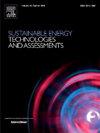A self-powered triboelectric wind detection sensor with adaptive electromagnetic damping adjusting mechanism
IF 7.1
2区 工程技术
Q1 ENERGY & FUELS
Sustainable Energy Technologies and Assessments
Pub Date : 2025-01-01
DOI:10.1016/j.seta.2024.104132
引用次数: 0
Abstract
Wind energy as a primary clean and non-polluting renewable energy source has unlimited prospects for development and research. Some challenges limit the harvesting performance of wind energy, such as severe generator starting torque and high material wear. To solve these issues, this paper proposes a thrust-bearing-based triboelectric sensor detection actuation (TENS-DA) system for optimizing the starting torque of electromagnetic wind generator. The proposed detection actuation system consists of 3 components: a point-contact thrust-bearing type triboelectric nanosensor (TENS), the long-short-term memory (LSTM) network deep learning algorithm, and a self-regulating circuit, which reduces both the starting torque of the generator and the wear of the material. The system uses TENS as a sensitive sensor to acquire the outside wind condition in real-time, and after the LSTM network reasoning out the result. Then the Raspberry Pi adjusts the effective number of coils of Electromagnetic generator (EMG) according to the result to realize the real-time regulation of EMG starting torque. The experimental results show that the peak value of the TENS-DA system output power is 1.17 W at a wind speed of 8 m/s. Furthermore, the TENS-DA system is capable of harvesting wind energy with a low wind speed of 1.3 m/s. With a sample size is 6000, the TENS-DA system has a wind speed detection accuracy of 96.13 %, which can accurately detect external wind conditions. Finally, the TENS-DA system detects outside wind conditions in real-time and adaptively regulates the starting torque of the EMG. This optimization strategy will provide essential guidance and reference for wind energy harvesting.
求助全文
约1分钟内获得全文
求助全文
来源期刊

Sustainable Energy Technologies and Assessments
Energy-Renewable Energy, Sustainability and the Environment
CiteScore
12.70
自引率
12.50%
发文量
1091
期刊介绍:
Encouraging a transition to a sustainable energy future is imperative for our world. Technologies that enable this shift in various sectors like transportation, heating, and power systems are of utmost importance. Sustainable Energy Technologies and Assessments welcomes papers focusing on a range of aspects and levels of technological advancements in energy generation and utilization. The aim is to reduce the negative environmental impact associated with energy production and consumption, spanning from laboratory experiments to real-world applications in the commercial sector.
 求助内容:
求助内容: 应助结果提醒方式:
应助结果提醒方式:


